
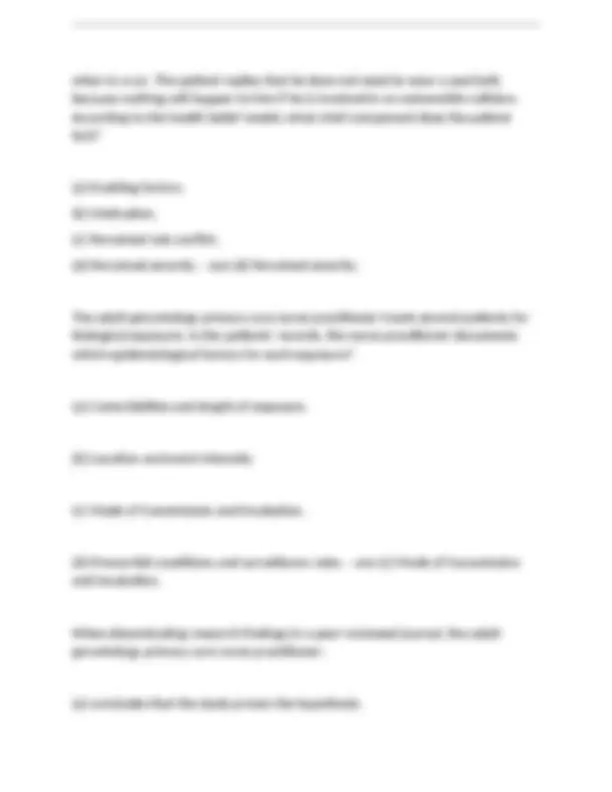
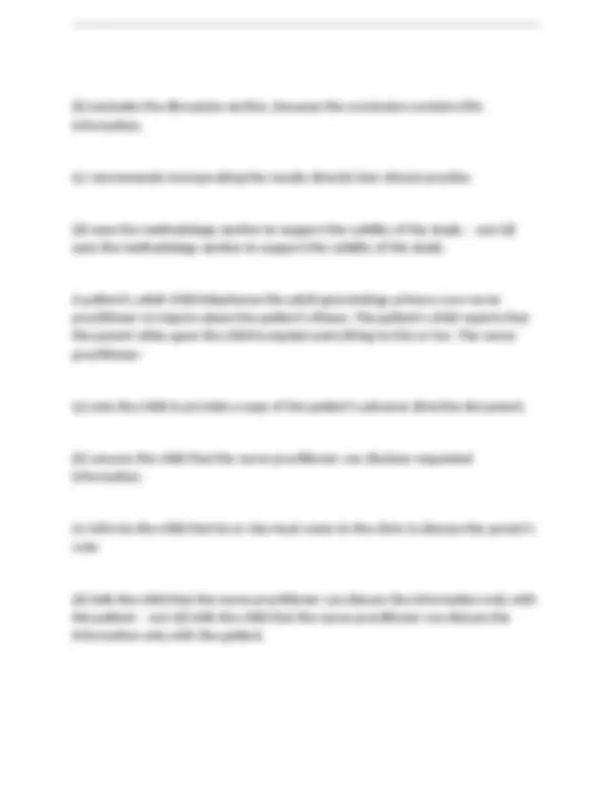
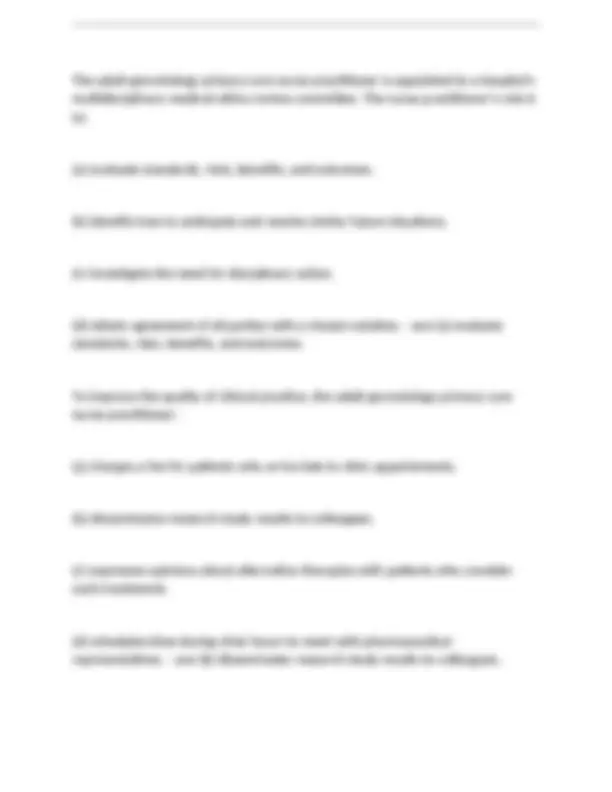
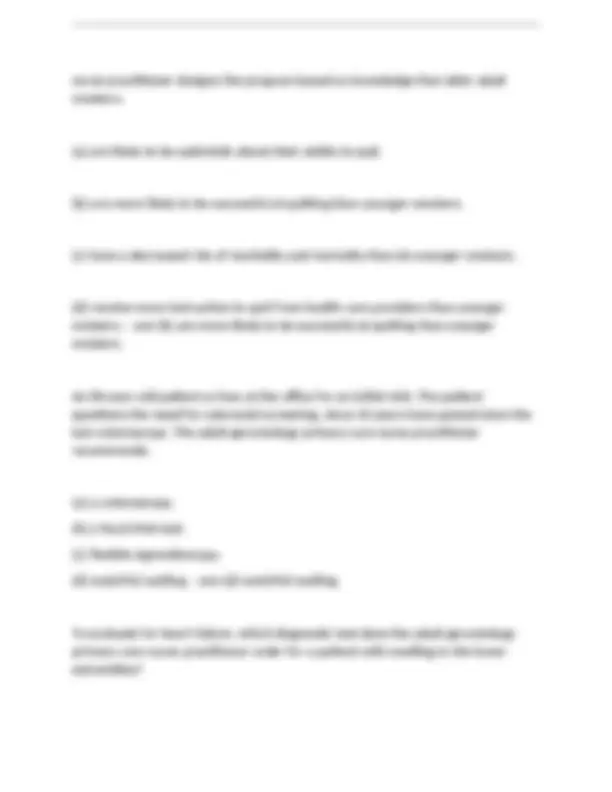
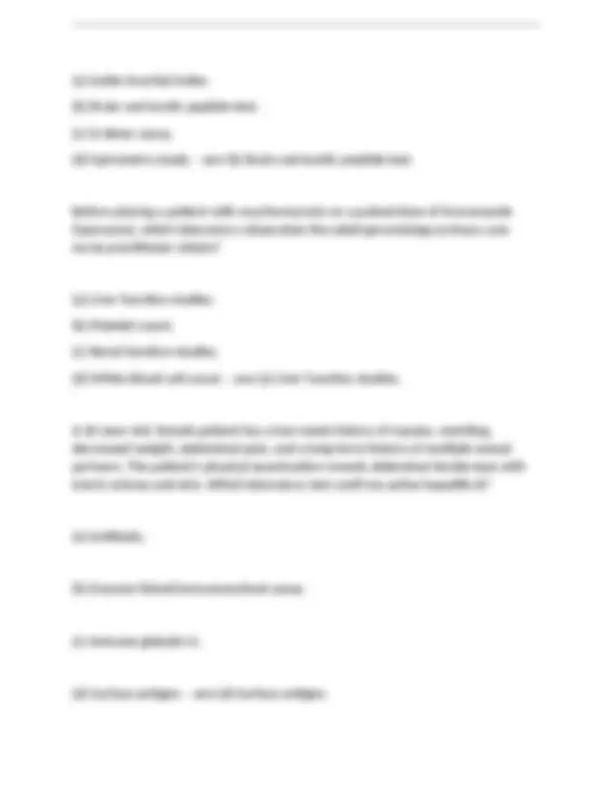
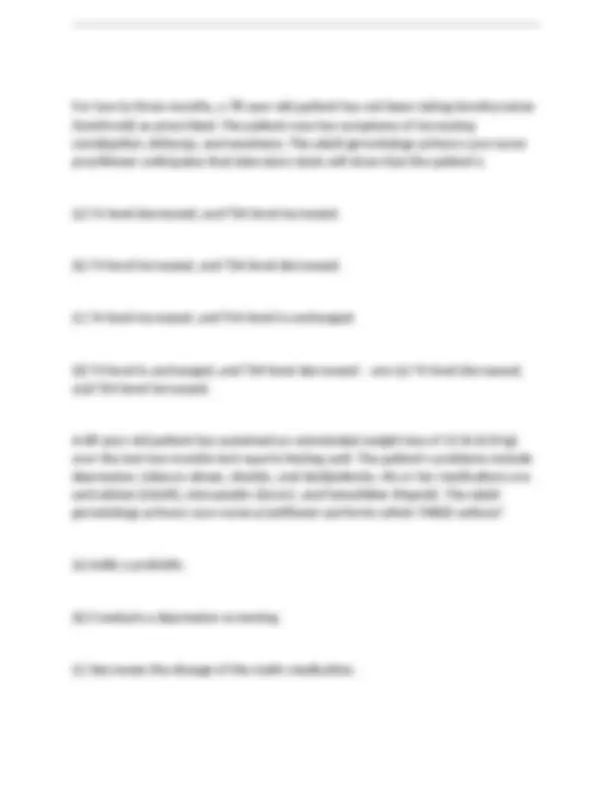
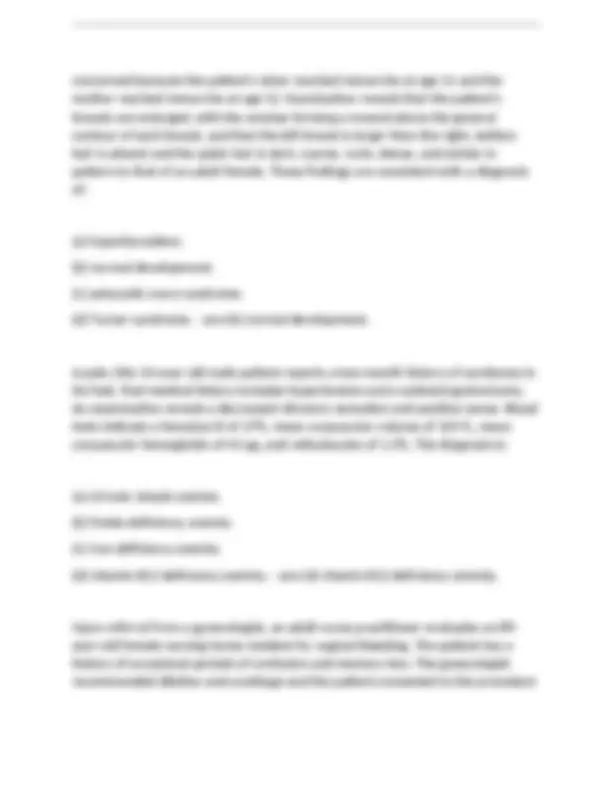
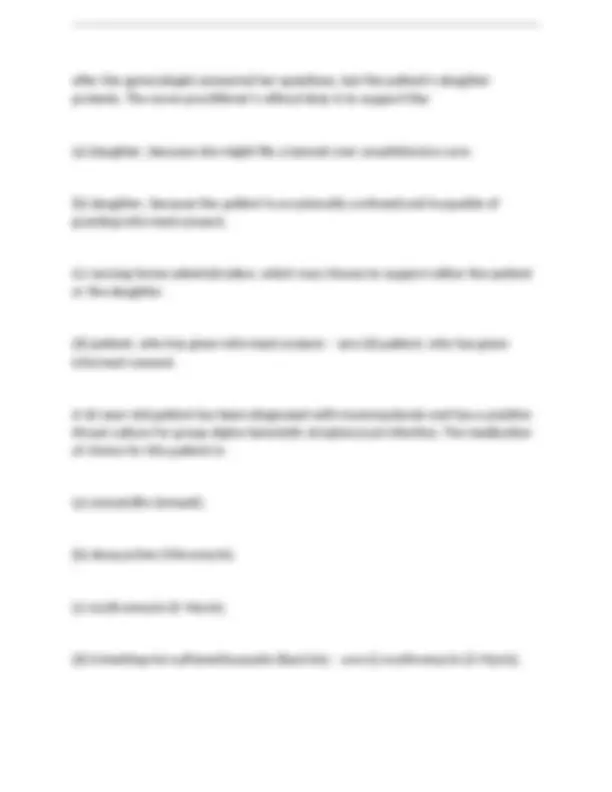
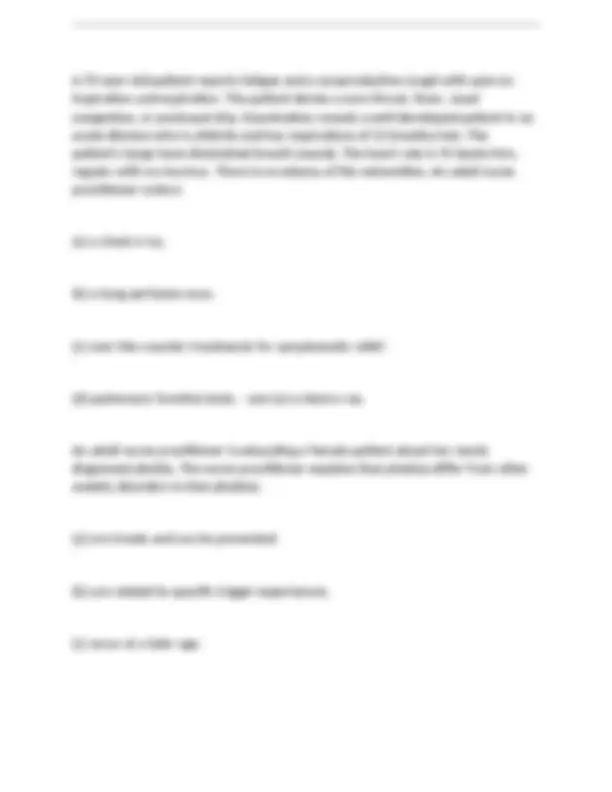
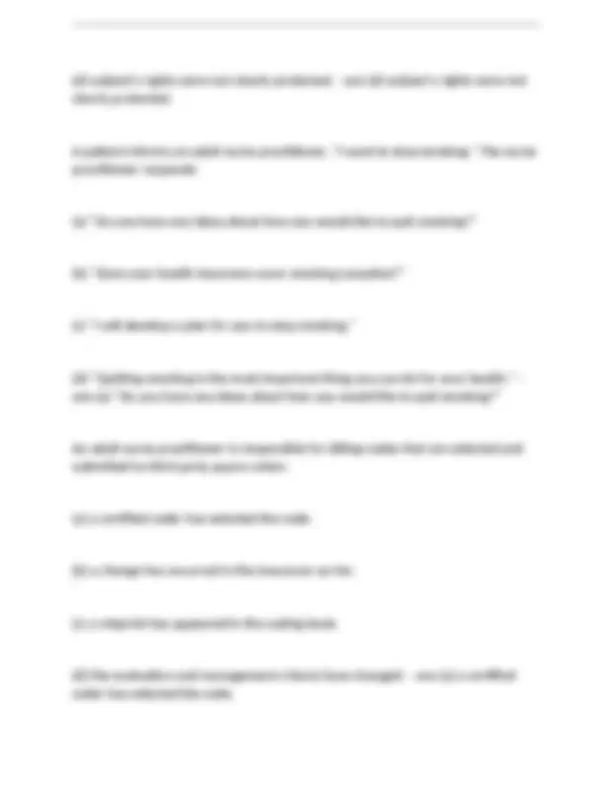
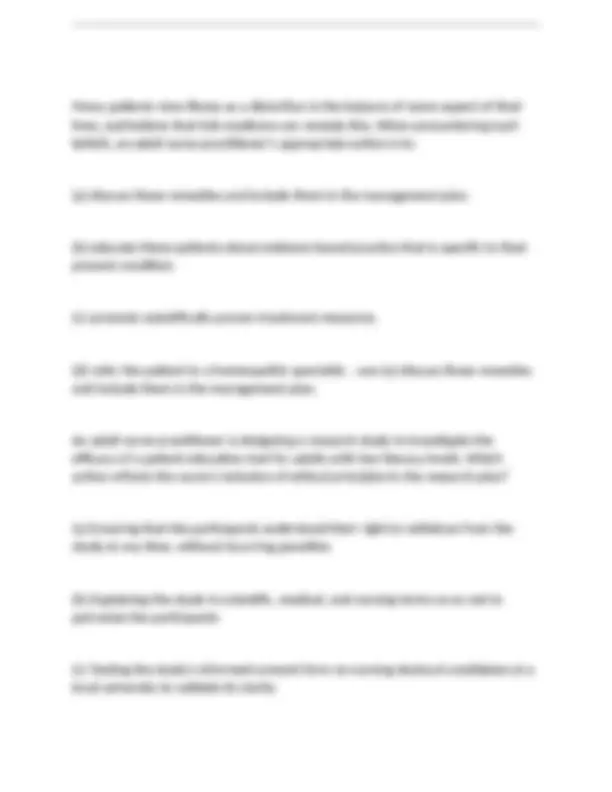
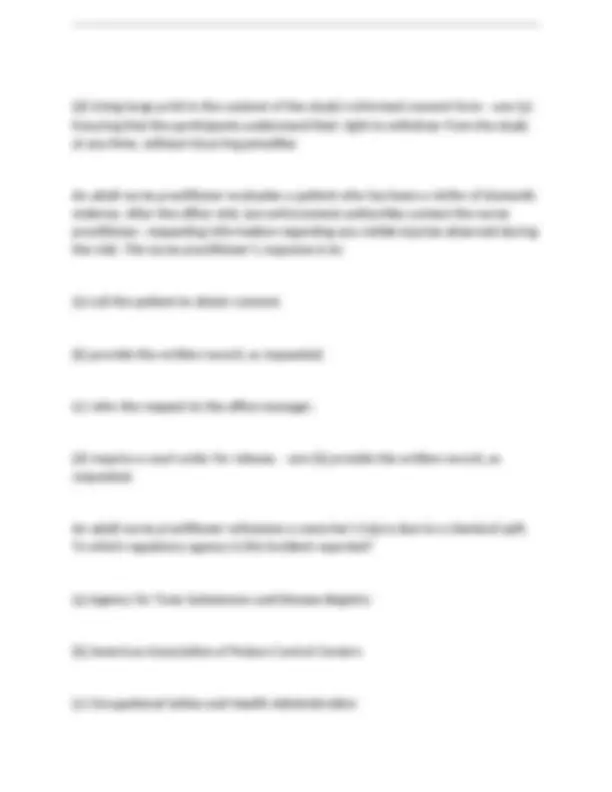
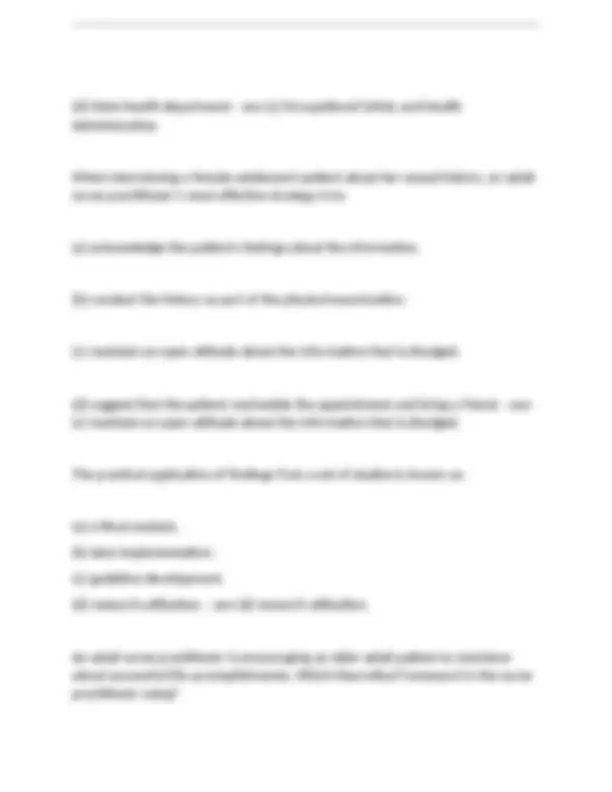
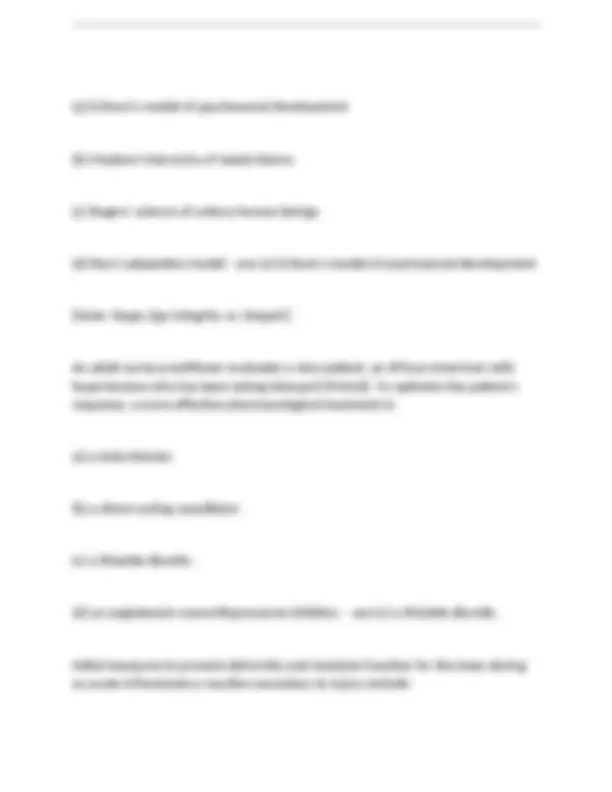
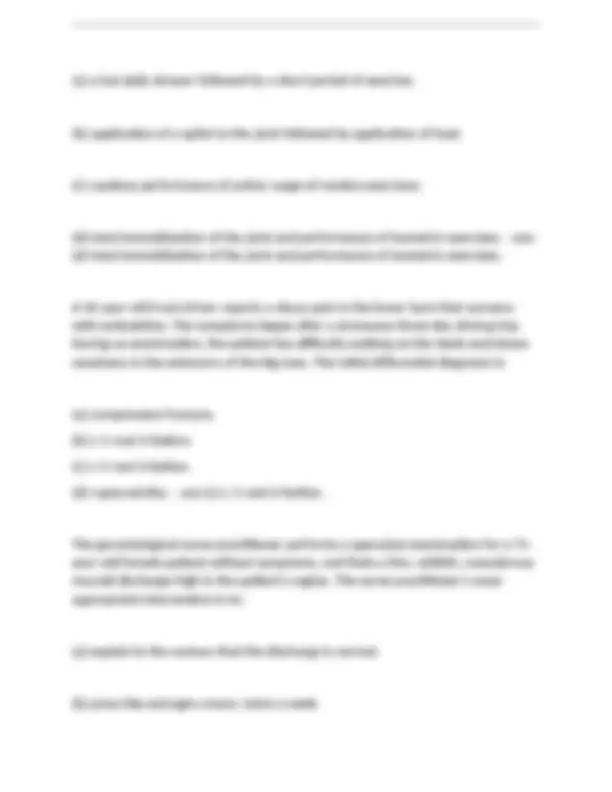
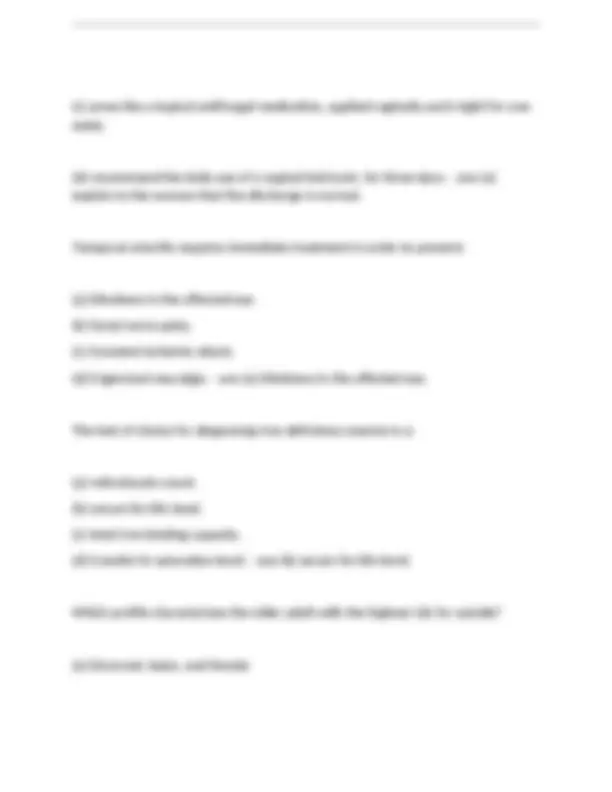
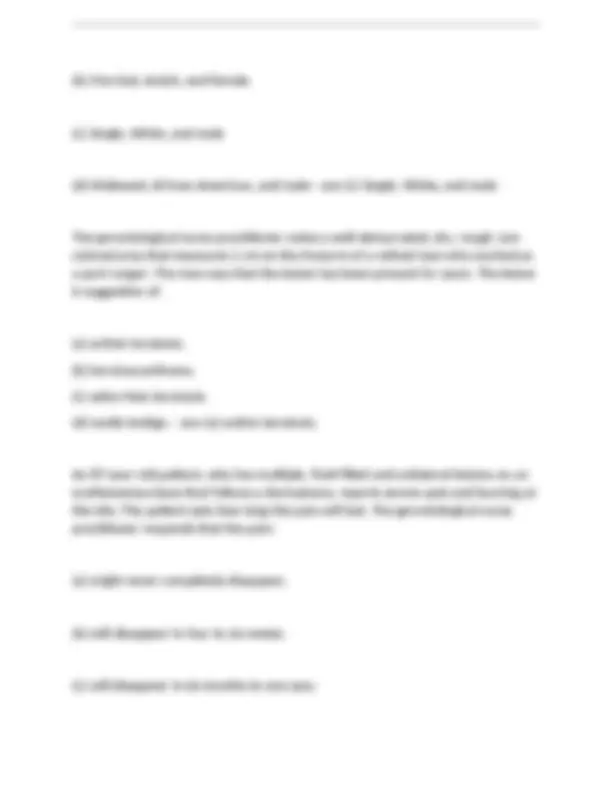
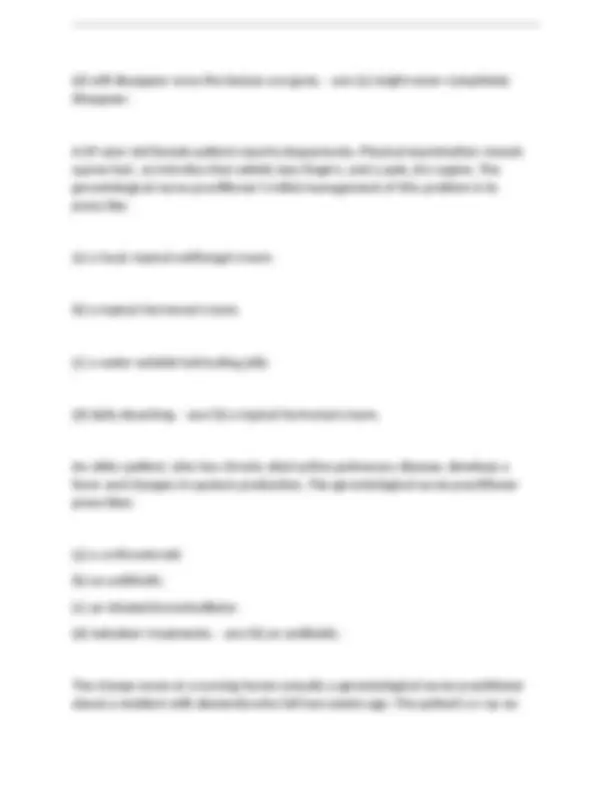
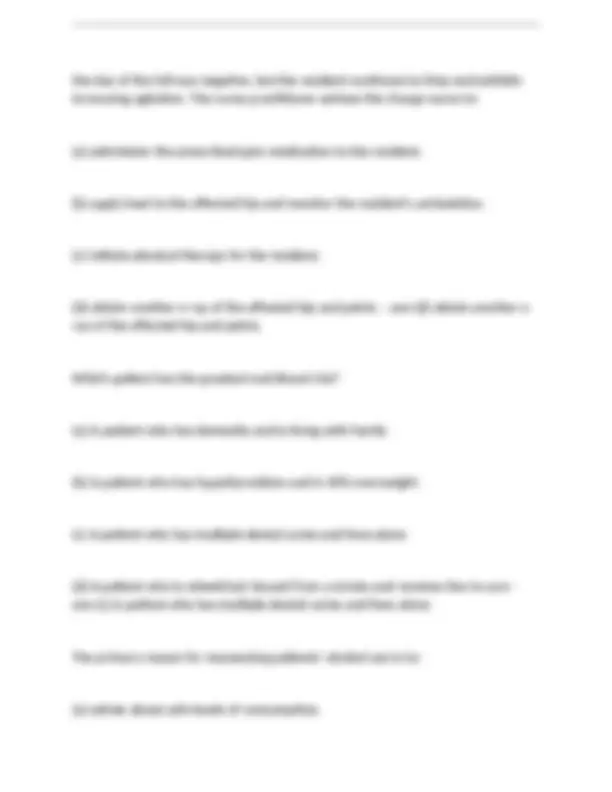
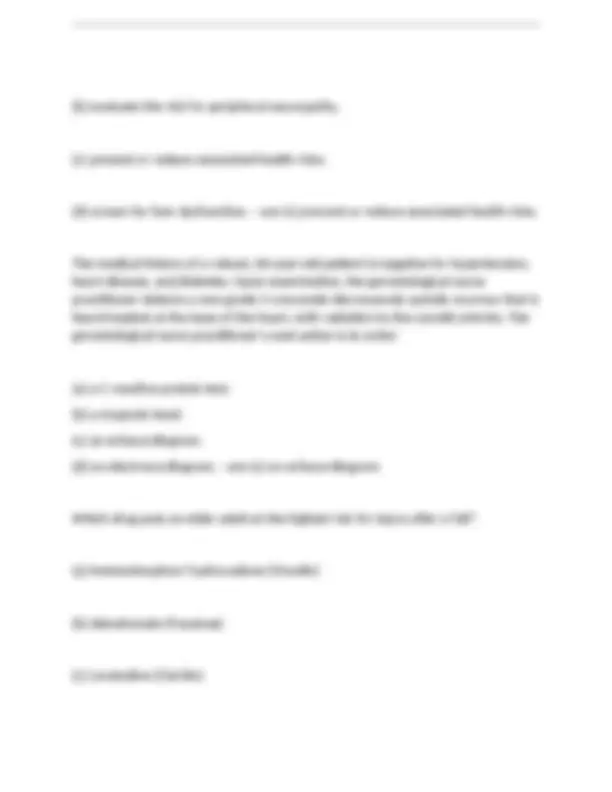
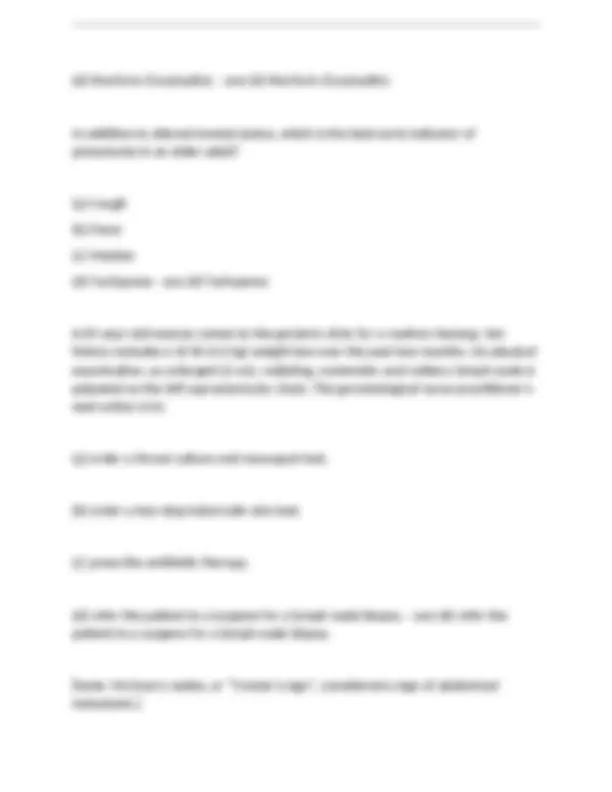
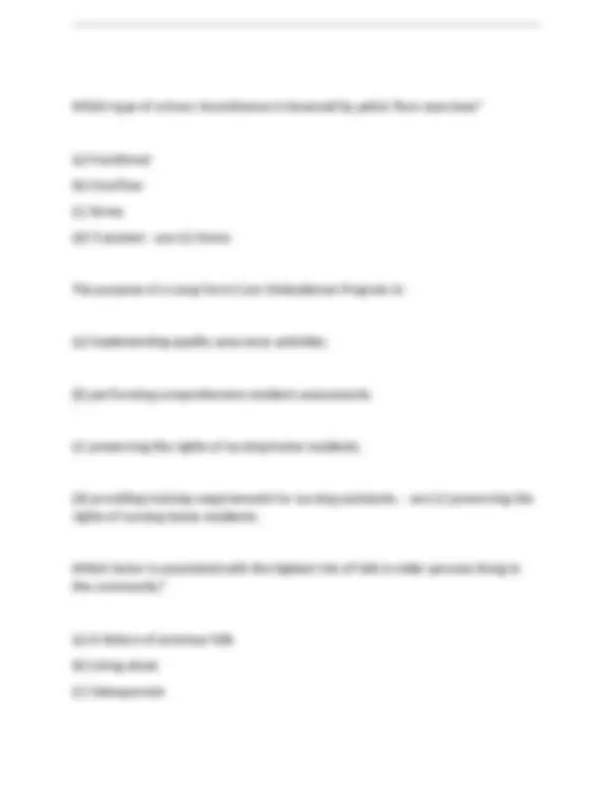
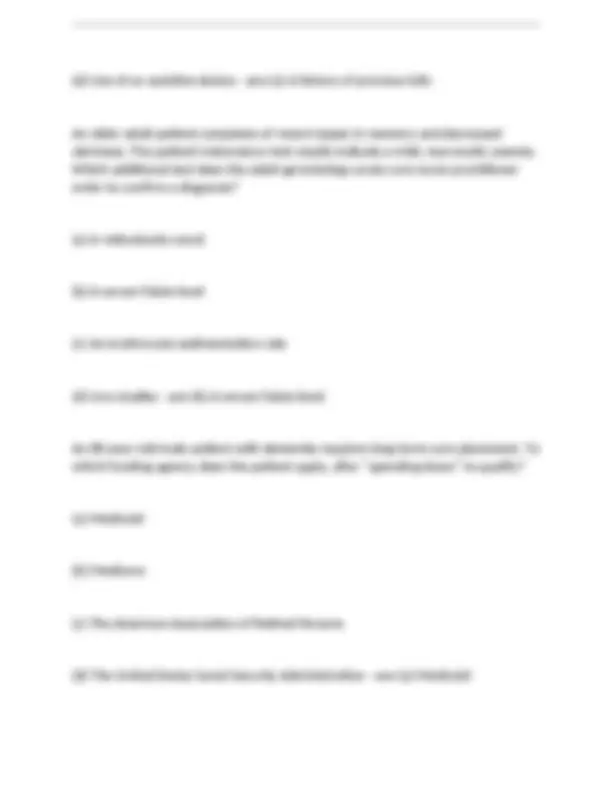
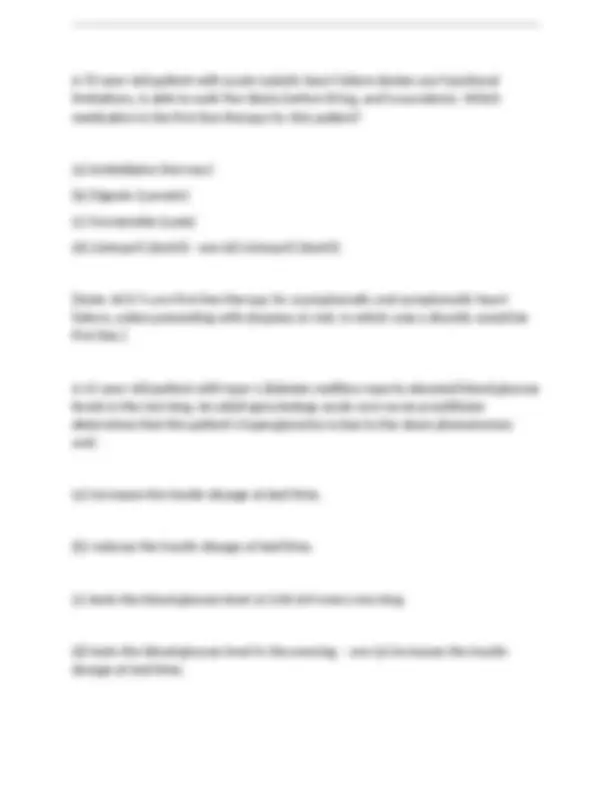
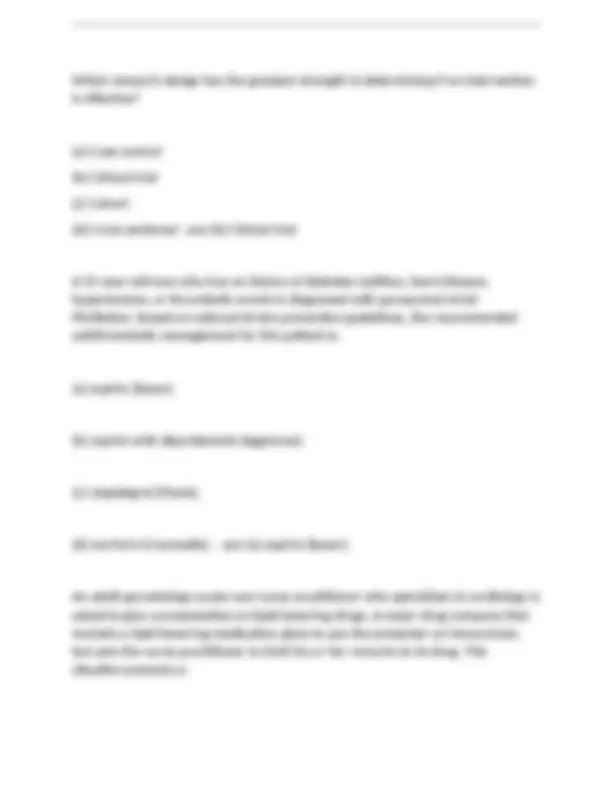
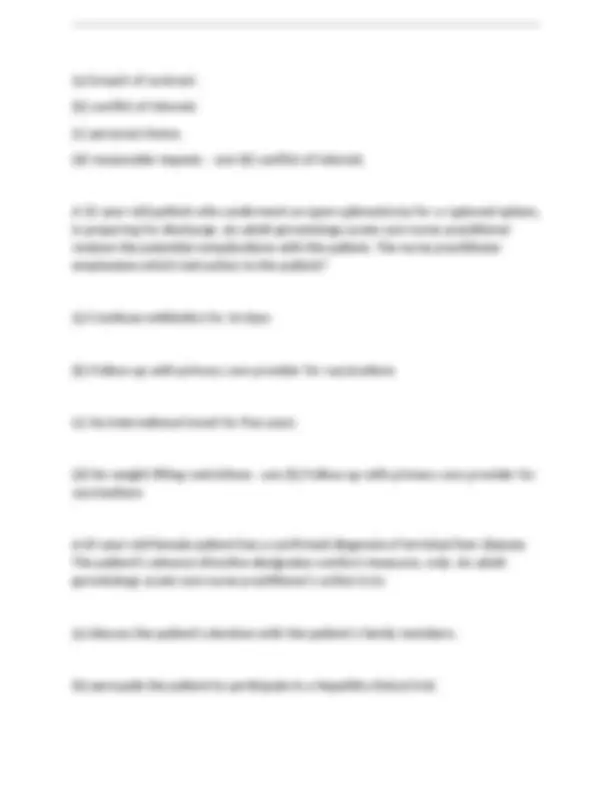
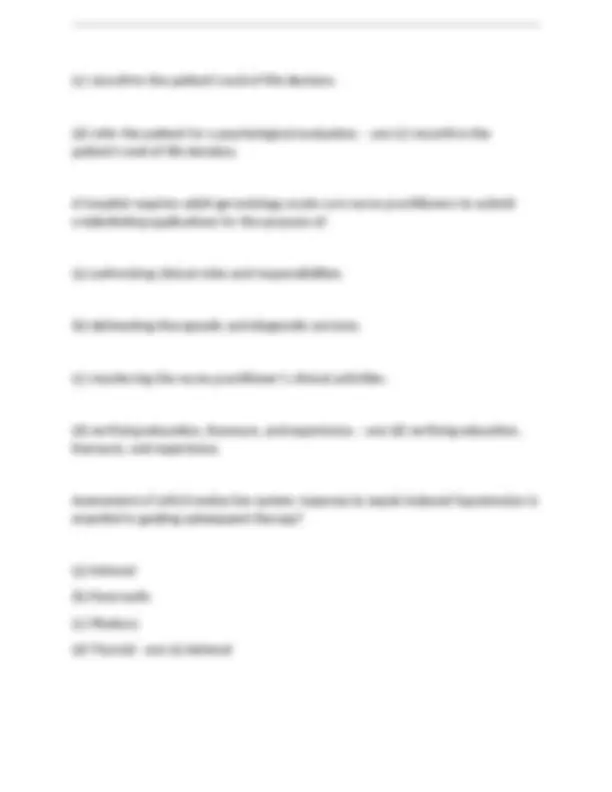
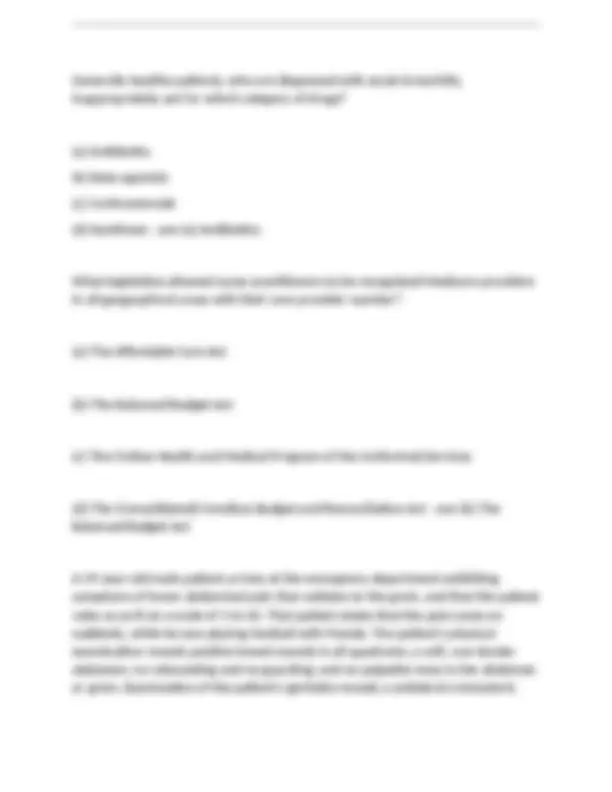
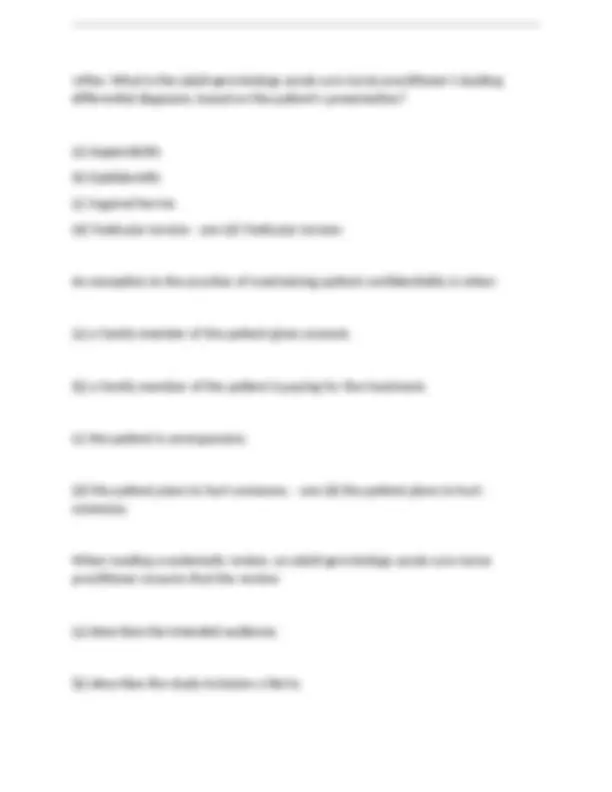
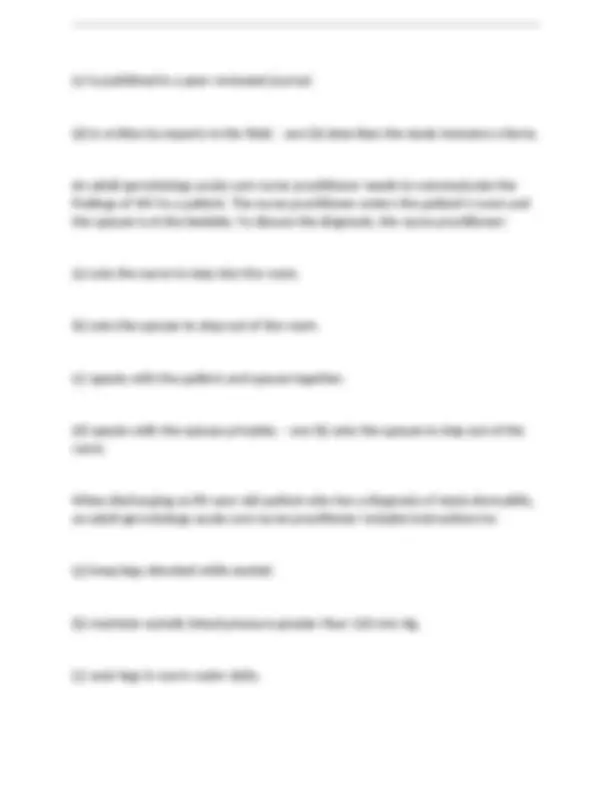
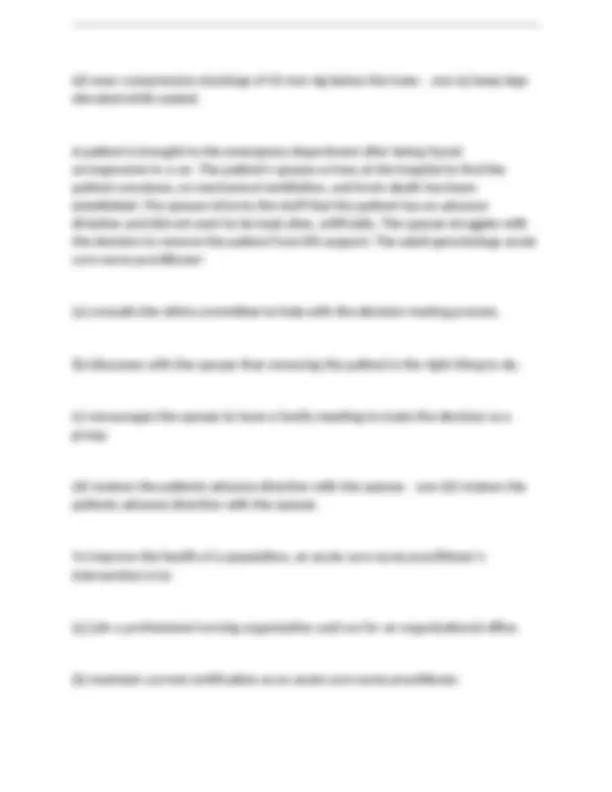
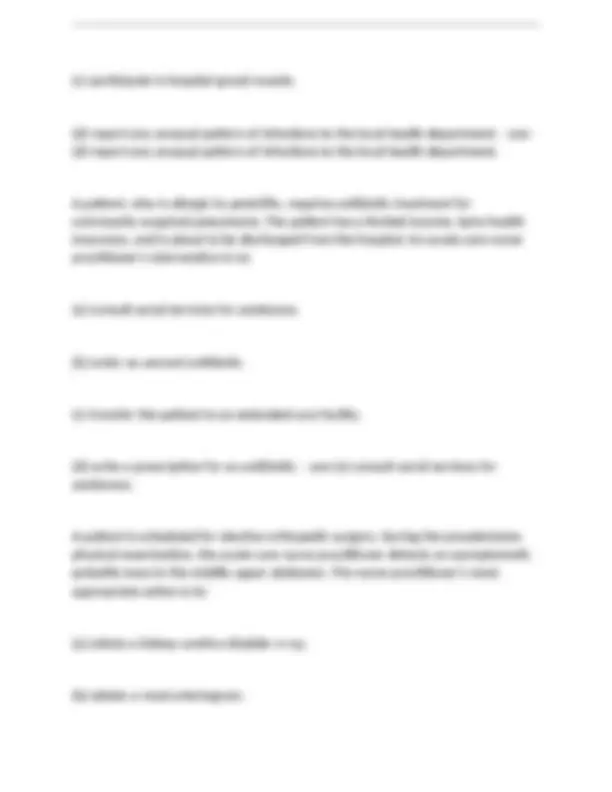
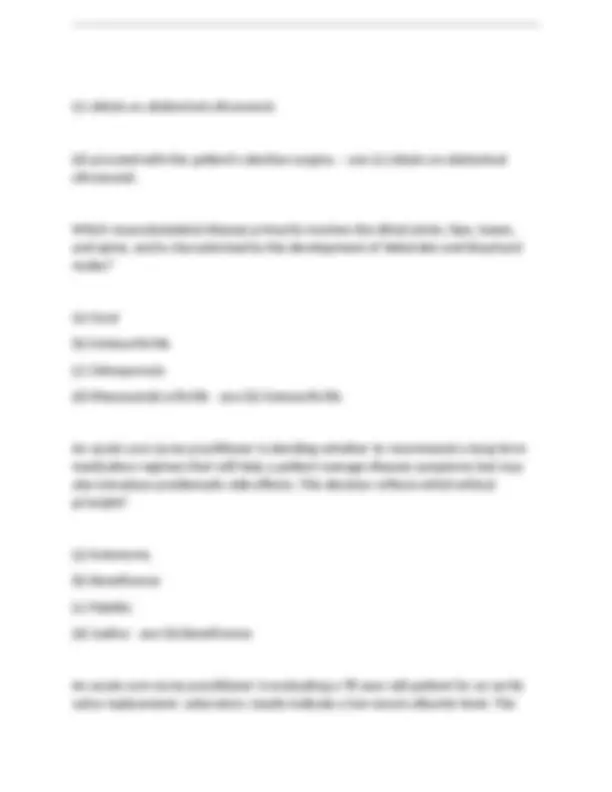
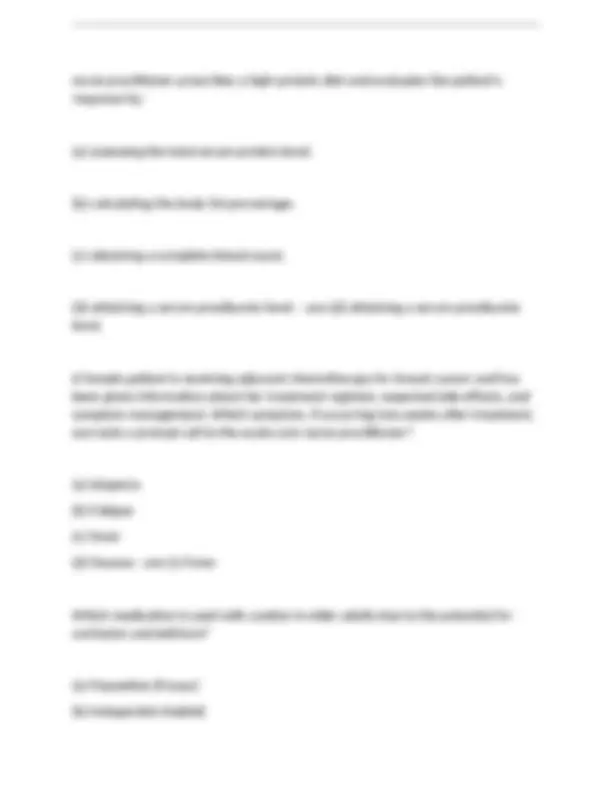
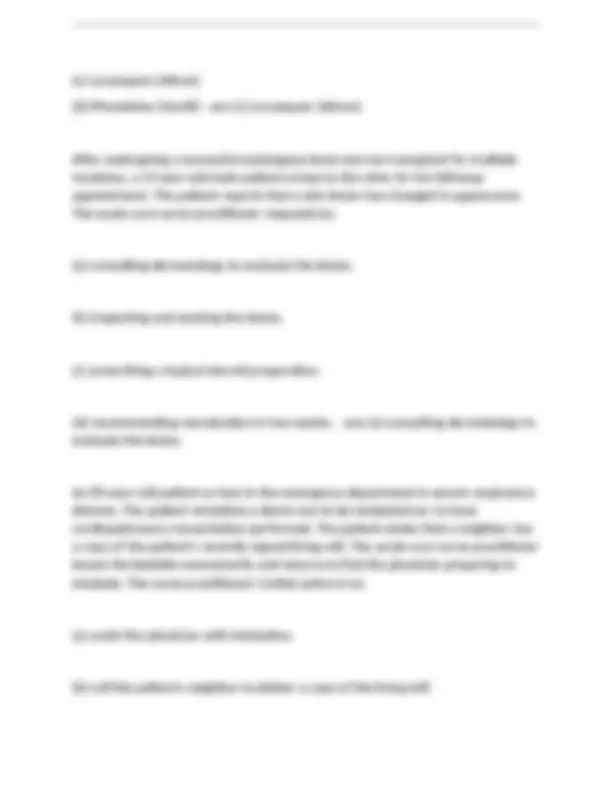
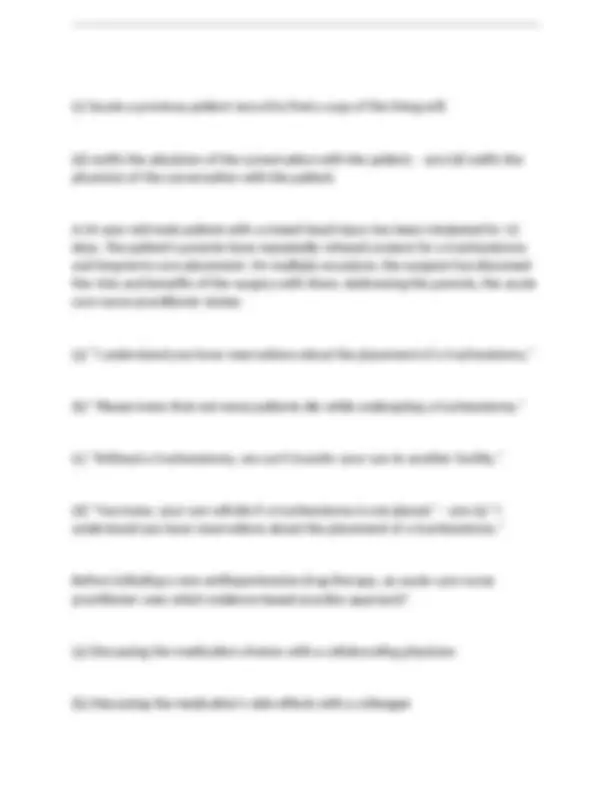
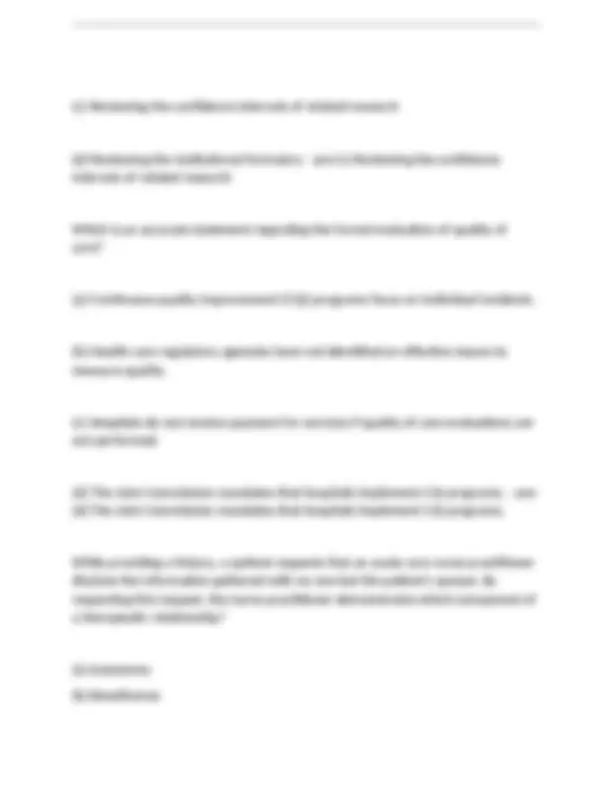
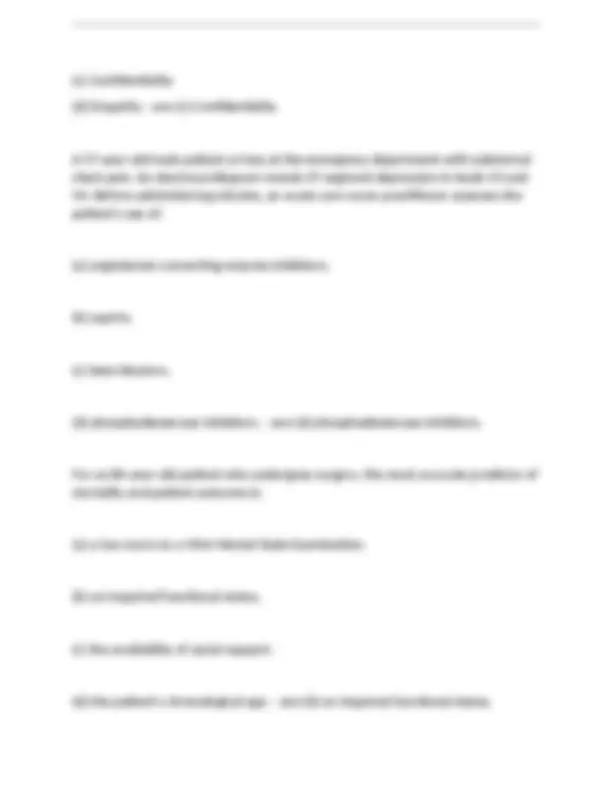
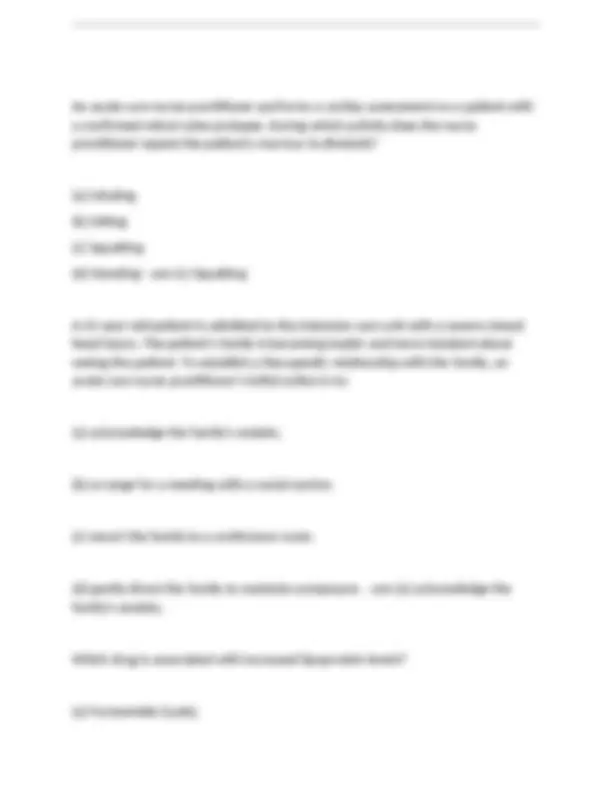
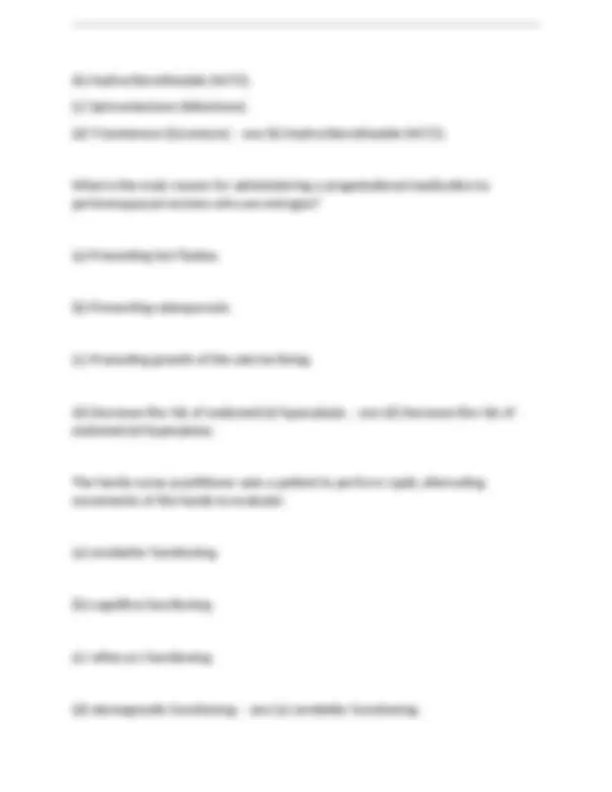
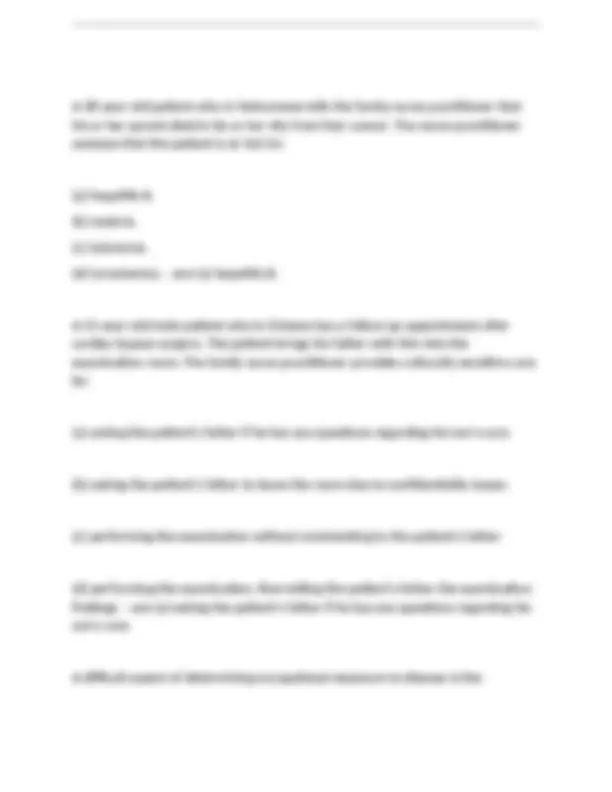
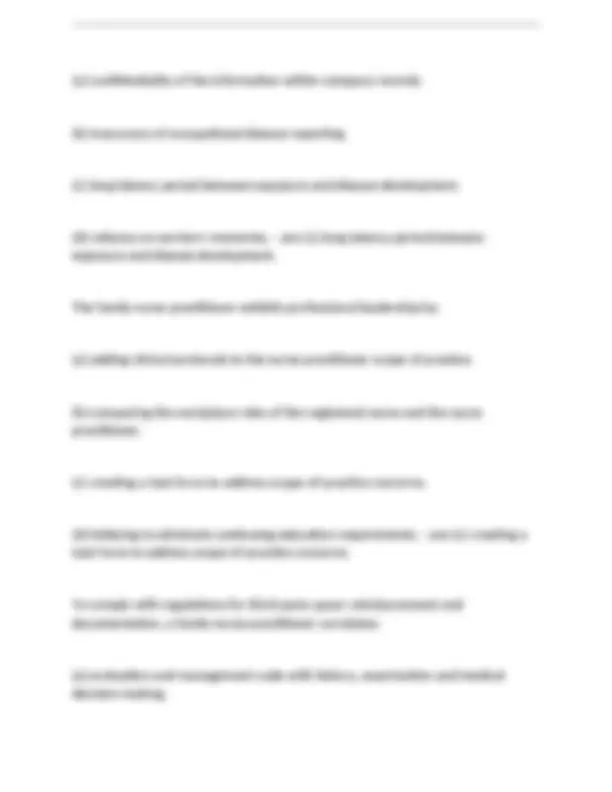

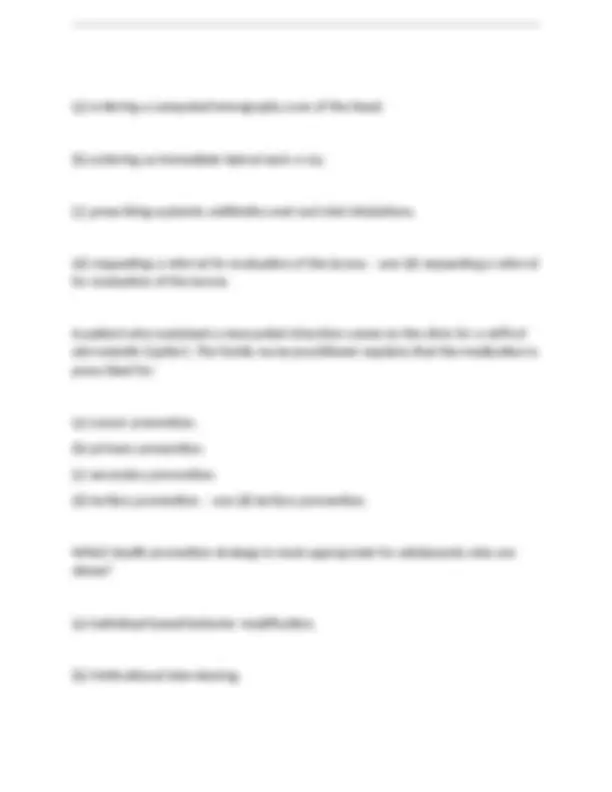
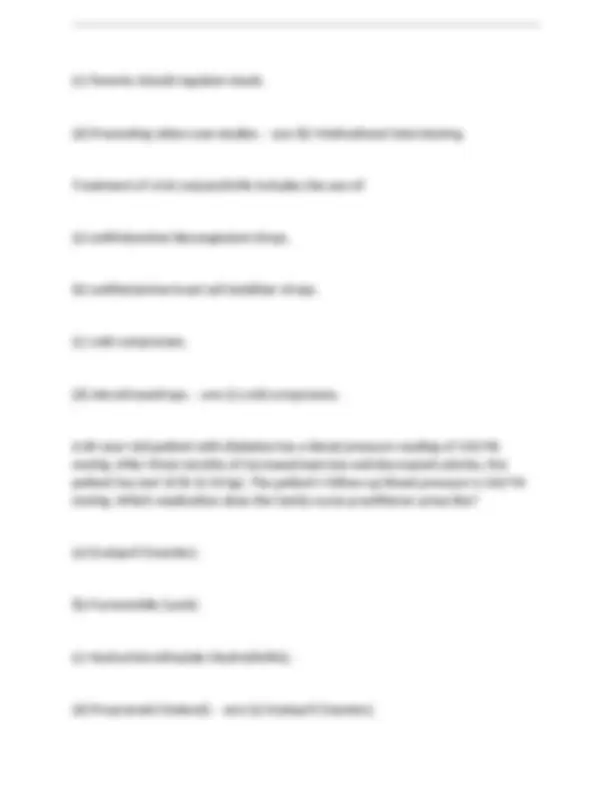
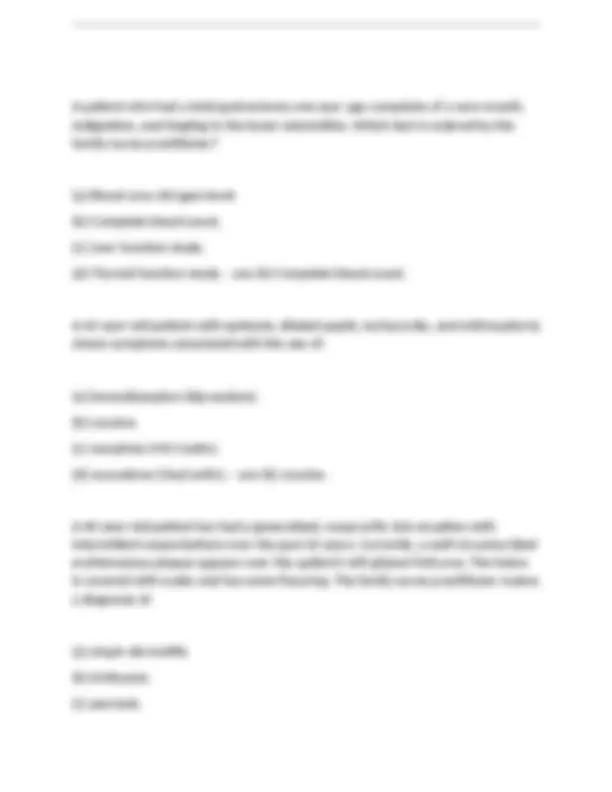
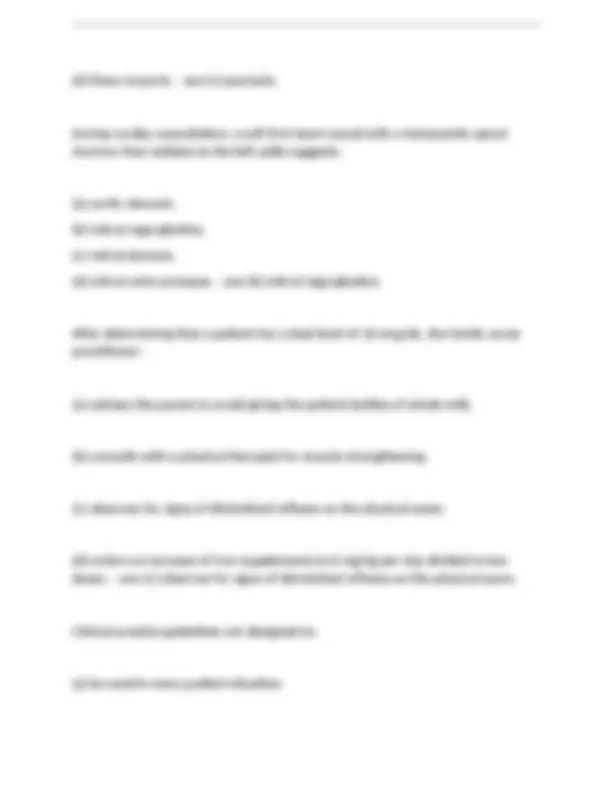
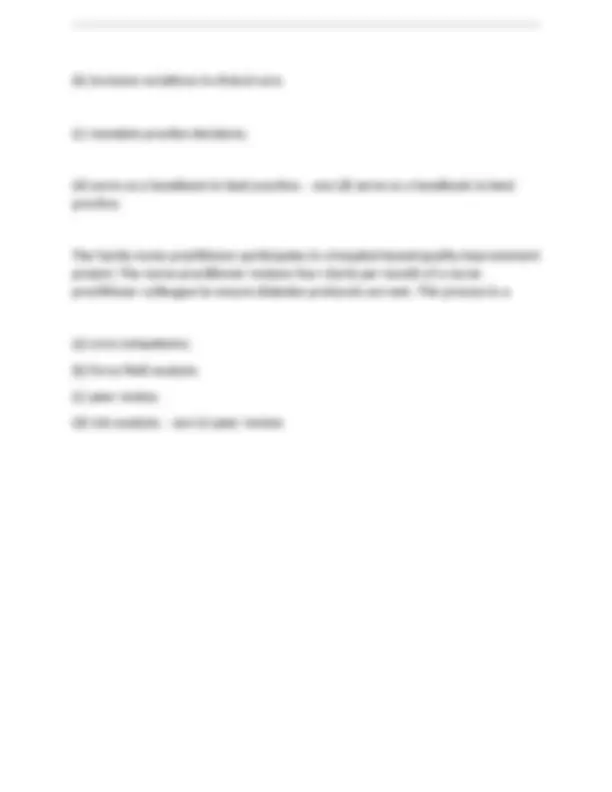


Study with the several resources on Docsity

Earn points by helping other students or get them with a premium plan


Prepare for your exams
Study with the several resources on Docsity

Earn points to download
Earn points by helping other students or get them with a premium plan
Community
Ask the community for help and clear up your study doubts
Discover the best universities in your country according to Docsity users
Free resources
Download our free guides on studying techniques, anxiety management strategies, and thesis advice from Docsity tutors
ANCC Practice Questions + correct answers graded A+.docx
Typology: Exams
1 / 56

This page cannot be seen from the preview
Don't miss anything!

















































In the early stages of iron deficient anemias, blood studies show: (a) macrocytic normochromic (b) microcytic hypochromic (c) normochromic normocytic (d) pancytopenic hypocytic - ans-(a) normochromic normocytic A 14-year-old, male patient has some general concerns about eczema, as his twin brother was recently diagnosed with this condition. The patient reports urticaria and a rash on his posterior knees bilaterally. The three factors that put the patient at risk for eczema are a family history of eczema, a personal history of allergic rhinitis, and a history of: (a) asthma (b) bee allergy (c) otitis media (d) psoriasis - ans-(a) asthma
A patient has hyperactive reflexes of the lower extremities. The adult-gerontology primary care nurse practitioner assesses for ankle clonus by: (a) firmly applying a low-pitched tuning fork to the lateral malleolus. (b) flexing the leg at the knee, rotating it externally, and striking the Achilles tendon with the percussion hammer. (c) sharply dorsiflexing the foot and maintaining this position while supporting the knee. (d) stroking the lateral aspect of the sole from the heel to the ball of the foot with the sharp end of the percussion hammer. - ans-(c) sharply dorsiflexing the foot and maintaining this position while supporting the knee. A 70-year-old, female patient is having her yearly evaluation. The adult- gerontology primary care nurse practitioner gives which physical examination finding the highest priority for immediate treatment? (a) Atrophy of vaginal rugae. (b) Cystocele present. (c) Palpable ovary. (d) Pessary in place. - ans-(c) Palpable ovary. The adult-gerontology primary care nurse practitioner reminds a 16-year-old, male patient who just received his driver's license to wear a seat belt at all times
(b) excludes the discussion section, because the conclusion contains this information. (c) recommends incorporating the results directly into clinical practice. (d) uses the methodology section to support the validity of the study. - ans-(d) uses the methodology section to support the validity of the study. A patient's adult child telephones the adult-gerontology primary care nurse practitioner to inquire about the patient's illness. The patient's child reports that the parent relies upon the child to explain everything to him or her. The nurse practitioner: (a) asks the child to provide a copy of the patient's advance directive document. (b) assures the child that the nurse practitioner can disclose requested information. (c) informs the child that he or she must come to the clinic to discuss the parent's case. (d) tells the child that the nurse practitioner can discuss the information only with the patient. - ans-(d) tells the child that the nurse practitioner can discuss the information only with the patient.
The adult-gerontology primary care nurse practitioner is appointed to a hospital's multidisciplinary medical ethics review committee. The nurse practitioner's role is to: (a) evaluate standards, risks, benefits, and outcomes. (b) identify how to anticipate and resolve similar future situations. (c) investigate the need for disciplinary action. (d) obtain agreement of all parties with a chosen solution. - ans-(a) evaluate standards, risks, benefits, and outcomes. To improve the quality of clinical practice, the adult-gerontology primary care nurse practitioner: (a) charges a fee for patients who arrive late to clinic appointments. (b) disseminates research study results to colleagues. (c) expresses opinions about alternative therapies with patients who consider such treatments. (d) schedules time during clinic hours to meet with pharmaceutical representatives. - ans-(b) disseminates research study results to colleagues.
(a) extroverted patient raising his or her grandchildren. (b) introverted patient who does not speak in the group. (c) personable patient who lives with his or her children. (d) worried patient whose son is serving in military conflict. - ans-(d) worried patient whose son is serving in military conflict. The adult-gerontology primary care nurse practitioner evaluates a patient with cold symptoms who reports smoking half a pack of cigarettes a day and shows no interest in quitting. The nurse practitioner's most appropriate approach is to treat the cold symptoms and: (a) advise the patient to stop smoking. (b) prescribe bupropion (Zyban). (c) raise the issue of smoking cessation at the next visit. (d) recommend that the patient select a low nicotine cigarette. - ans-(a) advise the patient to stop smoking. The adult-gerontology primary care nurse practitioner plans to provide smoking cessation education at a community center to older adults and their families. The
nurse practitioner designs the program based on knowledge that older adult smokers: (a) are likely to be optimistic about their ability to quit. (b) are more likely to be successful at quitting than younger smokers. (c) have a decreased risk of morbidity and mortality than do younger smokers. (d) receive more instruction to quit from health care providers than younger smokers. - ans-(b) are more likely to be successful at quitting than younger smokers. An 84-year-old patient arrives at the office for an initial visit. The patient questions the need for colorectal screening, since 10 years have passed since the last colonoscopy. The adult-gerontology primary care nurse practitioner recommends: (a) a colonoscopy. (b) a fecal DNA test. (c) flexible sigmoidoscopy. (d) watchful waiting. - ans-(d) watchful waiting. To evaluate for heart failure, which diagnostic test does the adult-gerontology primary care nurse practitioner order for a patient with swelling in the lower extremities?
For two to three months, a 78-year-old patient has not been taking levothyroxine (Synthroid) as prescribed. The patient now has symptoms of increasing constipation, lethargy, and weakness. The adult-gerontology primary care nurse practitioner anticipates that laboratory tests will show that the patient's: (a) T4 level decreased, and TSH level increased. (b) T4 level increased, and TSH level decreased. (c) T4 level increased, and TSH level is unchanged. (d) T4 level is unchanged, and TSH level decreased. - ans-(a) T4 level decreased, and TSH level increased. A 68-year-old patient has sustained an unintended weight loss of 15 lb (6.8 kg) over the last two months but reports feeling well. The patient's problems include depression, tobacco abuse, obesity, and dyslipidemia. His or her medications are sertralizine (Zoloft), simvastatin (Zocor), and famotidine (Pepcid). The adult- gerontology primary care nurse practitioner performs which THREE actions? (a) Adds a probiotic. (b) Conducts a depression screening. (c) Decreases the dosage of the statin medication.
(d) Obtains a chest x-ray. (e) Orders a thyroid-stimulating hormone. - ans-(b) Conducts a depression screening. (d) Obtains a chest x-ray. (e) Orders a thyroid-stimulating hormone. Preparing to implement an incontinence reduction program at a nursing home, the adult-gerontology primary care nurse practitioner reviews several studies. Place the studies in sequential order of the strength of evidence for this population from strongest to weakest. (a) A case report of an experimental incontinence reduction program in older adults. (b) A consensus statement from the urologic association regarding the use of scheduled toileting. (c) A systematic review of nonrandomized trials concerning the use of vaginal estrogen. - ans-Strongest evidence: (c) a systematic review ...then: (b) a consensus statement Weakest evidence: (a) a case report
concerned because the patient's sister reached menarche at age 11 and the mother reached menarche at age 12. Examination reveals that the patient's breasts are enlarged, with the areolae forming a mound above the general contour of each breast, and that the left breast is larger than the right. Axillary hair is absent and the pubic hair is dark, coarse, curly, dense, and similar in pattern to that of an adult female. These findings are consistent with a diagnosis of: (a) hypothyroidism. (b) normal development. (c) polycystic ovary syndrome. (d) Turner syndrome. - ans-(b) normal development. A pale, thin 54-year-old male patient reports a two-month history of numbness in his feet. Past medical history includes hypertension and a subtotal gastrectomy. An examination reveals a decreased vibratory sensation and position sense. Blood tests indicate a hematocrit of 27%, mean corpuscular volume of 105 fL, mean corpuscular hemoglobin of 45 pg, and reticulocytes of 1.5%. The diagnosis is: (a) chronic simple anemia. (b) folate deficiency anemia. (c) iron deficiency anemia. (d) vitamin B12 deficiency anemia. - ans-(d) vitamin B12 deficiency anemia. Upon referral from a gynecologist, an adult nurse practitioner evaluates an 89- year-old female nursing home resident for vaginal bleeding. The patient has a history of occasional periods of confusion and memory loss. The gynecologist recommended dilation and curettage and the patient consented to the procedure
after the gynecologist answered her questions, but the patient's daughter protests. The nurse practitioner's ethical duty is to support the: (a) daughter, because she might file a lawsuit over unsatisfactory care. (b) daughter, because the patient is occasionally confused and incapable of granting informed consent. (c) nursing home administration, which may choose to support either the patient or the daughter. (d) patient, who has given informed consent. - ans-(d) patient, who has given informed consent. A 16-year-old patient has been diagnosed with mononucleosis and has a positive throat culture for group Alpha-hemolytic streptococcal infection. The medication of choice for this patient is: (a) amoxicillin (Amoxil). (b) doxycycline (Vibramycin). (c) erythromycin (E-Mycin). (d) trimethoprim-sulfamethoxazole (Bactrim). - ans-(c) erythromycin (E-Mycin).
(d) often involve depressive symptoms. - ans-(b) are related to specific trigger experiences. A 78-year-old male patient comes to the ambulatory care clinic and reports an inability to void. The adult nurse practitioner has difficulty inserting a urinary catheter due to an obstruction. The nurse practitioner's action is to: (a) obtain consent from the patient to perform prostatic massage. (b) perform a suprapubic aspiration to relieve bladder distention. (c) prescribe an oral loop diuretic. (d) refer the patient to a urologist for further treatment. - ans-(d) refer the patient to a urologist for further treatment. A patient comes to the clinic with reports of acute pain and loss of vision in the right eye. The adult nurse practitioner informs the patient that these symptoms require: (a) assessment with a split lamp. (b) examination with an otoscope. (c) immediate referral to an ophthalmologist.
(d) treatment with several ophthalmologic agents. - ans-(c) immediate referral to an ophthalmologist. A 45-year-old patient with diabetes comes to the clinic for an annual appointment. The patient declines a parenteral influenza vaccination because a friend "came down with the flu after receiving the vaccination." The adult nurse practitioner explains that the vaccination is: (a) a polysaccharide, so it may cause a mild case of influenza. (b) activated, so it may cause a mild case of influenza. (c) inactivated, and this is unable to cause influenza. (d) live attenuated, so it may cause a mild case of influenza. - ans-(c) inactivated, and this is unable to cause influenza. An institutional review board rejects an adult nurse practitioner's research proposal on the grounds that the: (a) chosen statistics were not optimal to meet research objectives. (b) literature review was insufficient to develop the research question. (c) proposed budget did not cover the cost of the study.
Many patients view illness as a distortion in the balance of some aspect of their lives, and believe that folk medicine can remedy this. When encountering such beliefs, an adult nurse practitioner's appropriate action is to: (a) discuss these remedies and include them in the management plan. (b) educate these patients about evidence-based practice that is specific to their present condition. (c) promote scientifically proven treatment measures. (d) refer the patient to a homeopathic specialist. - ans-(a) discuss these remedies and include them in the management plan. An adult nurse practitioner is designing a research study to investigate the efficacy of a patient education tool for adults with low literacy levels. Which action reflects the nurse's inclusion of ethical principles in the research plan? (a) Ensuring that the participants understand their right to withdraw from the study at any time, without incurring penalties (b) Explaining the study in scientific, medical, and nursing terms so as not to patronize the participants (c) Testing the study's informed consent form on nursing doctoral candidates at a local university to validate its clarity
(d) Using large print in the content of the study's informed consent form - ans-(a) Ensuring that the participants understand their right to withdraw from the study at any time, without incurring penalties An adult nurse practitioner evaluates a patient who has been a victim of domestic violence. After the office visit, law enforcement authorities contact the nurse practitioner, requesting information regarding any visible injuries observed during the visit. The nurse practitioner's response is to: (a) call the patient to obtain consent. (b) provide the written record, as requested. (c) refer the request to the office manager. (d) require a court order for release. - ans-(b) provide the written record, as requested. An adult nurse practitioner witnesses a coworker's injury due to a chemical spill. To which regulatory agency is this incident reported? (a) Agency for Toxic Substances and Disease Registry (b) American Association of Poison Control Centers (c) Occupational Safety and Health Administration